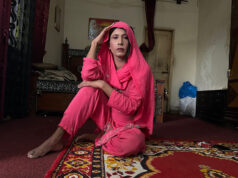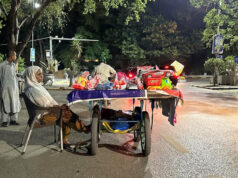Tahira Khan
Sana Gul*, Harnai, Balochistan, is one of those women who got married before 15 years. Her family started looking for her marriage when she reached the stage of puberty. Unfortunately, in Balochistan, a research report “ Child Marriage in Balochistan: A Political Economy Analysis” indicates that 12.5% are married before fifteen years old while 45 % are married before turning eighteen. Sana Gul is one of those women who bore the burden of girl-child marriage because it is one of the common practices in her area. She is the eldest of five sisters and her family thought to marry her as early as possible because they have to set arrangements for other sisters as well.
Following that, Sana Gul* mentioned her younger sister also got married before 18. When asked about the reasons, she made poverty and illiteracy responsible for the girl-child marriages along with other social norms and tribal setups.
Dr. Faryal Khan, Lady Medical Officer (LMO) at Kacchi district (Bolan), said that marriages before 15 and 18 are directly linked with the net income of families. The poorer the family the greater be occurrence of girl-child marriage. She also mentioned that if we look into the poor households of Kacchi there will higher prevalence of child marriages whereas in Quetta the number decreases because of the urban middle class who are somehow financially stable. Generally, poor households have minimal opportunities and resources to invest in girls. Besides, parents see girls as a burden and marriage relieves them of this economic liability.
Maryum Aman, the multimedia journalist, also endorsed the economic factor behind early marriages. According to her, parents’ cost-benefit analysis puts girls at a disadvantage position especially when price is offered in exchange for marriage. Similarly, in such cases, prices are set in accordance with the age of the brides- the younger the bride, the higher the price.
In such spirit, Ms Aman mentioned that financial transition has led to dowry practice as well where the bride provides assets to the family of the groom. In that context, younger brides need less dowry as compared to brides above 18. This again incentivizes families to go for early marriages. However, these financial benefits help the bride’s parents but do not serve the bride at all.
Naz Khala*, a resident of the Loralai district, said that social and tribal practices led the way to girl-child marriages such as settling property conflicts, tribal disputes, and blood feuds. It is a common tribal practice to give away girls as animals to settle blood money or bring harmony between different tribes. In one of the surveys titled “Customary Marriages in Rural Pakistan”, 2017, it is revealed that Balochistan has the highest percentage of child marriages in the form of Vanni, Swara, Badal, Bazo, and Sang Chatthi which constitutes 22-24 percent. Moreover, the survey also indicated that the prevalence of other practices such as selling of brides is 17 percent whereas Badle-Sulah is 3 percent.
Consequently, early marriages alter the educational trajectory of women as well. If a girl is married before 18, her formal schooling is most likely to stop. This devoid women of acquiring skills and knowledge that are crucial to take care of their households. Girl brides are most often removed from social structures that schools provide which lowers their level of productivity in communities. Clarence Tsimpo, Economist in the Poverty Global Practice at the World Bank, has indicated that early marriages decrease the 4-6 % probability of a girl joining the school.
Fatima Gul*, a government teacher, also commented on the matter. She detailed that the girl stopped studying right after engagement. I have seen many families who do not allow their daughters-in-law to go to college/ school or they prefer to sit in private exams. Besides, many districts in the province such as Loralai and Kohlu have one college where transport inaccessibility to far-flung associated villages proved to be the main hurdle and girls prefer to stay at home rather than spend fifteen to twenty thousand on transportation. Young married girls can not move freely and lack of transportation in far-off villages permanently devoid girls of their right to education. This is one of the factors that girl-child marriages are more abundant in rural areas as compared to urban centers.
It is pertinent to mention that limited access of women to formal education also hampers their access to the labor market. The labor force requires secondary and post-secondary education that women don’t acquire when they are married before 18. Indeed, for formal and paid labor, women are required to get marketable skills and knowledge. On the other hand, women after getting married confine themselves to home-based work with lower or almost non-existent income. In 2020, UNFPA released a report titled “Child Marriage in Balochistan: A Political Economy Analysis” which suggested that only 9.5 percent of women, aged 20-24, are employed which could drop to 6.5% if they go for marriage. On the other hand, 77 percent are already out of the labor market and one of the factors is girls child marriage.
Dr Nazish Baloch, registrar in BMC, said that people usually don’t reflect upon the adverse health impacts of early child marriages and frequent pregnancies. One of the most common impacts in recent years is seen in the form of obstetric fistula in young girls. In 2017, the International Center for Research on Women (ICRW) and World Bank concluded in one of their studies that a decrease in child marriage means lower fertility rates and more GDP per capita in countries where child marriage is a common practice.
As per the Pakistan Demographic and Health Survey (PDHS), 2017-18, six percent of girls are married before 15 while approximately twenty-one percent are married before 18. One of the research reports titled “Economic Impacts of Child Marriage: A Review Literature”, 2014, states that if the current trends around the globe continue it will result in 140 million girls’ child marriages at the end of 2030.
Statistically, the UNFPA report “Child Marriage in Balochistan: A Political Economy Analysis” explains that girl-child marriage is prevalent in most of the districts of Balochistan. In this context, Makran with twenty-three percent ranks on the top where brides are found to be under eighteen years of age followed by Nasirabad and Sibi Divisions. At the division level, five divisions have a high percentage of marriages before 18 as compared to the provincial average I.e. 17.6%. Concerning marriage before 15, Makran, Nasirabad, and Kalat top the list in the province.
As far as the district-level data is concerned, Kech shows a higher prevalence of marriages under fifteen followed by Harnai I.e. 10.3% and 9.7% respectively. However, data suggest that Kech, Kohlu, and Killa Saifullah are among the top districts where women are married before eighteen years. Overall, twelve districts have shown a twenty percent prevalence of marrying girls before eighteen.
Globally, girl-child marriage is prohibited under different treaties and human rights conventions. One of the foremost is the Universal Declaration of Human Rights (UDHR), 1945, along with other institutional frameworks including The International Covenant on Economic, Social and Cultural Rights (ICESCR), 1960, Convention on the Rights of the Child (CRC), 1989, Women (CEDAW), 1979, UN Convention on Consent to Marriage etc. have called to end child marriages.
In contrast, at the provincial level, the legal framework to end girl-child marriage is almost non-existent. However, the Federal Child Marriage Restraint Act, of 1929, prohibits marriage before sixteen for girls whereas eighteen for boys. However, scholars and practitioners indicate that the Federal Child Marriage Act is not usually applied in cases of child marriages. Moreover, the punishment prescribed in the federal act is also minimal I.e., one month imprisonment or a fine of 1000 rupees.
Accordingly, Advocate Sadia Ali mentions that there is some progress on women’s development but the country still lacks a national policy on women. As far as Balochistan is concerned, child marriages are prevalent due to cultural, religious, and tribal traditions. Besides, she stated that lack of education and awareness along with tribal codes of conduct such as Tribal Baloch Law and Pakhtunwali paved the way for women’s only role as “honor guardians’’. This honor concept is deeply ingrained in a native tribal context that ultimately rejects any other notion related to women’s respect and dignity along with defying any other legal framework. It is due to these traditions that bound women behind the four walls of home and discouraged them from doing jobs or asking for their rights. Consequently, natives prefer to go for early marriages as their traditional values and dignity lie in marriage and taking care of the household.
Resultantly, she reiterated that the NGOs and civil society organization raises the agenda to end girl child marriage whereas indigenous support is minimal in the province. More recently, lawmakers have tried to table a Bill on child marriage to raise the minimum age limit up to 18. Unfortunately, the bill did not garner enough debate and support from opposition parties to process it within the assembly. Further, it is also feared that the bill has lapsed for the third time because the substance of the bill did not conform to the existing norms of the social structures.
Fozia Shaheen, Chairperson of the Balochistan Commission on Status of Women (BCSW), also shed light on the matter of dilution of substance within the Child Marriage draft bill. According to her, few provisions within the bill were deemed controversial on religious grounds. In the previous bill, the court was allowed to dissolve the child marriage due to which the bill lapsed many times. However, she further noticed that BCSW along with the previous cabinet has drafted the revised version of the child marriage bill in consultation with the Federal Shariat Court. In this bill, a clause has been added that a girl child, age 16, can be married only if she provides consent before the family court. Otherwise, no parent or guardian is allowed to arrange a marriage for girls under 18.
Similarly, the revised draft bill has also removed the dissolution of the marriage clause which is suggested to be unacceptable given the orthodox culture of the tribal society of Balochistan. When asked about why the revised bill also lapsed she commented it was due to the dissolution of the Assembly in August. It is hoped that after the general elections in 2024, the bill will again be presented in the Balochistan Assembly for further debate and expert viewpoints
Razia Hazara, a psychologist based in Quetta, said that girl-child marriages either are the outcome of individual choices or a group decision-making process. Psychologically, the reasons behind these marriages are complex and derived from the amalgamation of culture, economy, society, and religion. Firstly, She stated that people tend to go for early child marriage because they think a certain age figure is suitable for marriage otherwise, their child would get too old.
In the same vein, she stated that the girl-child marriage saves parents from heavy dowry and other educational and health expenses. Moreover, she maintained that it is a common misconception among people that girl marriage may end harassment, rape, elopement, self-arranged marriages, premarital love affairs, etc. Regrettably, the moral code of conduct is highly conservative and has psychologically imprisoned society as well.
The writer holds an M.Phil Degree in South Asian Studies from the University of Punjab. She can be reached on Twitter @TahiraGhilzai.
Click here to read previous articles of the writer.
Share your comments!








